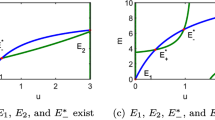Abstract
The evolution of cooperation is an intriguing puzzle in evolutionary biology. Several examples have been described where individual microbial cells cooperate by secreting products that are beneficial for the whole community, but reduce the fitness of the producing cells. The spatial distribution within the community provides a solution that can explain the evolution and stability of cooperative interactions.
Similar content being viewed by others
Literatur
West SA, Griffin AS, Gardner A (2007) Evolutionary explanations for cooperation. Curr Biol 17:661–672
Travisano M, Velicer GJ (2004) Strategies of microbial cheater control. Trends Microbiol 12:72–78
van Dyken JD, Müller MJ, Mack KM et al. (2013) Spatial population expansion promotes the evolution of cooperation in an experimental Prisoner’s Dilemma. Curr Biol 23:919–923
van Gestel J, Weissing FJ, Kuipers OP et al. (2014) Density of founder cells affects spatial pattern formation and cooperation in Bacillus subtilis biofilms. ISME J 8:2069–2079
Müller MJ, Neugeboren BI, Nelson DR et al. (2014) Genetic drift opposes mutualism during spatial population expansion. Proc Natl Acad Sci USA 111:1037–1042
Momeni B, Brileya KA, Fields MW et al. (2013) Strong inter-population cooperation leads to partner intermixing in microbial communities. Elife 2:e00230
Momeni B, Waite AJ, Shou W (2013) Spatial self-organization favors heterotypic cooperation over cheating. Elife 2:e00960
Author information
Authors and Affiliations
Corresponding author
Additional information
Theresa Hölscher Jahrgang 1990. 2009–2012 Biologiestudium (Bachelor) an der Universität Gießen. 2012–2014 Mikrobiologiestudium (Master) an der Universität Jena. Seit 2015 Doktorandin im Institut für Mikrobiologie an der Universität Jena mit Unterstützung der International Max Planck Research School für chemische Ökologie (IMPRS).
Christian Kost Jahrgang 1975. 1995–2001 Biologiestudium an der Universität Kaiserslautern. 2006 Promotion am Max-Planck-Institut für chemische Ökologie, Jena. 2006–2008 Postdoc bei Prof. Dr. P. Rainey, Massey University Auckland, Neuseeland. Seit 2009 Leiter der unabhängigen Forschergruppe „Experimentelle Ökologie und Evolution“ am Max-Planck-Institut für chemische Ökologie, Jena.
Ákos T. Kovács Jahrgang 1977. 1995–2000 Biologiestudium an der Universität Szeged, Ungarn; dort 2003 Promotion am Lehrstuhl für Biotechnologie. 2005–2012 Postdoc am Lehrstuhl für Genetik an der Universität Groningen, Niederlande. Seit 2012 Leiter der unabhängigen Nachwuchsgruppe „Terrestrische Biofilme“ am Institut für Mikrobiologie der Universität Jena.
Rights and permissions
About this article
Cite this article
Hölscher, T., Kost, C. & Kovács, Á.T. Einblicke in das Sozialleben von Mikroben. Biospektrum 21, 264–266 (2015). https://doi.org/10.1007/s12268-015-0569-8
Published:
Issue Date:
DOI: https://doi.org/10.1007/s12268-015-0569-8




